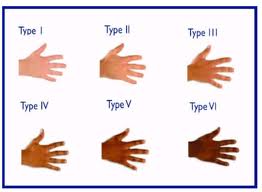Dark Skinned adults need more than 45 minutes of UK summer sun daily
Efficacy of a dose range of simulated sunlight exposures in raising vitamin D status in South Asian adults: implications for targeted guidance on sun exposure
Am J Clin Nutr June 2013 vol. 97 no. 6 1210-1216
Mark D Farrar, Ann R Webb, Richard Kift, Marie T Durkin, Donald Allan, Annie Herbert, Jacqueline L Berry, and Lesley E Rhodes
Dermatology Centre, Institute of Inflammation and Repair (MDF, MTD, DA, and LER), and the Institute of Population Health (AH), University of Manchester, Manchester Academic Health Science Centre, Salford Royal National Health Service Foundation Trust, Manchester, United Kingdom; the School of Earth, Atmospheric and Environmental Sciences, University of Manchester, Manchester, United Kingdom (ARW and RK); and the Endocrinology and Diabetes Research Group, Institute of Human Development, University of Manchester, Manchester Academic Health Science Centre, Manchester Royal Infirmary, Manchester, United Kingdom (JLB).
Supported by Cancer Research UK (grant C20668/A10007).
Address correspondence to LE Rhodes, Photobiology Unit, Dermatology Centre, University of Manchester, Salford Royal National Health Service Foundation Trust, Manchester M6 8HD, United Kingdom. E-mail: [email protected].
Background: Vitamin D is essential for bone health, and cutaneous synthesis is an important source. South Asians cannot attain adequate amounts of vitamin D by following general recommendations on summer sunlight exposure at northerly latitudes, and increased exposure may be appropriate for improving their vitamin D status.
Objective: We examined the efficacy of a dose range of simulated summer sunlight exposures in raising vitamin D status in UK adults of South Asian ethnicity.
Design: In a dose-response study, healthy adults of South Asian ethnicity (n = 60; 20–60 y old) received 1 of 6 ultraviolet exposures ranging from 0.65 to 3.9 standard erythema doses (SEDs), which were equivalent to 15–90 min unshaded noontime summer sunlight at 53.5°N (Manchester, United Kingdom), 3 times/wk for 6 wk, while wearing casual clothes that revealed a 35% skin area. Serum 25-hydroxyvitamin D [25(OH)D] was measured weekly, and dietary vitamin D was estimated.
Results: At baseline, all completing participants (n = 51) were vitamin D insufficient [25(OH)D concentrations <20 ng/mL], and a high proportion of participants were deficient [35% of subjects had 25(OH)D concentrations <5 ng/mL], and 90% of subjects had 25(OH)D concentrations <10 ng/mL, which are concentrations at which osteomalacia and rickets occur). The 25(OH)D concentration rose significantly in all dose groups. Postcourse, all participants achieved 25(OH)D concentrations ≥5 ng/mL, whereas only 6 subjects attained 25(OH)D concentrations ≥20 ng/mL. Participants who received exposures ≥1.95 SEDs (equivalent to 45 min unshaded sunlight; n = 33) attained a mean (±SD) 25(OH)D concentration of 15.7 ± 5 ng/mL (mean rise: 8.7 ± 5.7 ng/mL; 95% CI: 6.8, 10.6 ng/mL; P < 0.001), and 94% of subjects achieved concentrations >10 ng/mL.
Conclusions: Targeted guidance on sunlight exposure could usefully enhance vitamin D status to avoid deficiency [25(OH)D concentration >10 ng/mL] in South Asians living at latitudes distant from the equator. This trial was registered at the ISRCTN Register (www.isrctn.org) as 07565297.
Received November 18, 2012. Accepted March 25, 2013.
Summary by Vitamin D Life
60 subjects with type 5 skin, 35% skin area, 6 weeks
6 UV levels
Probably 10 subjects got 90 minutes of noon sun 3 days a week
40% of those did not get to even 20 ng
20 ng is great in the UK, since the recommended level is a meager 10 ng (:confused:)
Interesting delay: Published results in June 2013, yet the trial was completed 4 years before
See also Vitamin D Life
Vitamin D reduced so low that Victorian age diseases are returning
Immigrants and refugees had lower vitamin D levels – Jan 2013
Differences in black and non-black mortality and vitamin D – Oct 2012
98 percent of black women had less than 20 ng of vitamin D – July 2012
Half of the US will be people of color – wonder how many will be vitamin D deficient
Extra 4,000 IU daily raised the vitamin D levels of blacks to that of whites – July 2012
80 percent of South Asian Women in UK had less than 10 ng of vitamin D in winter – April 2012
All items in Europe items

